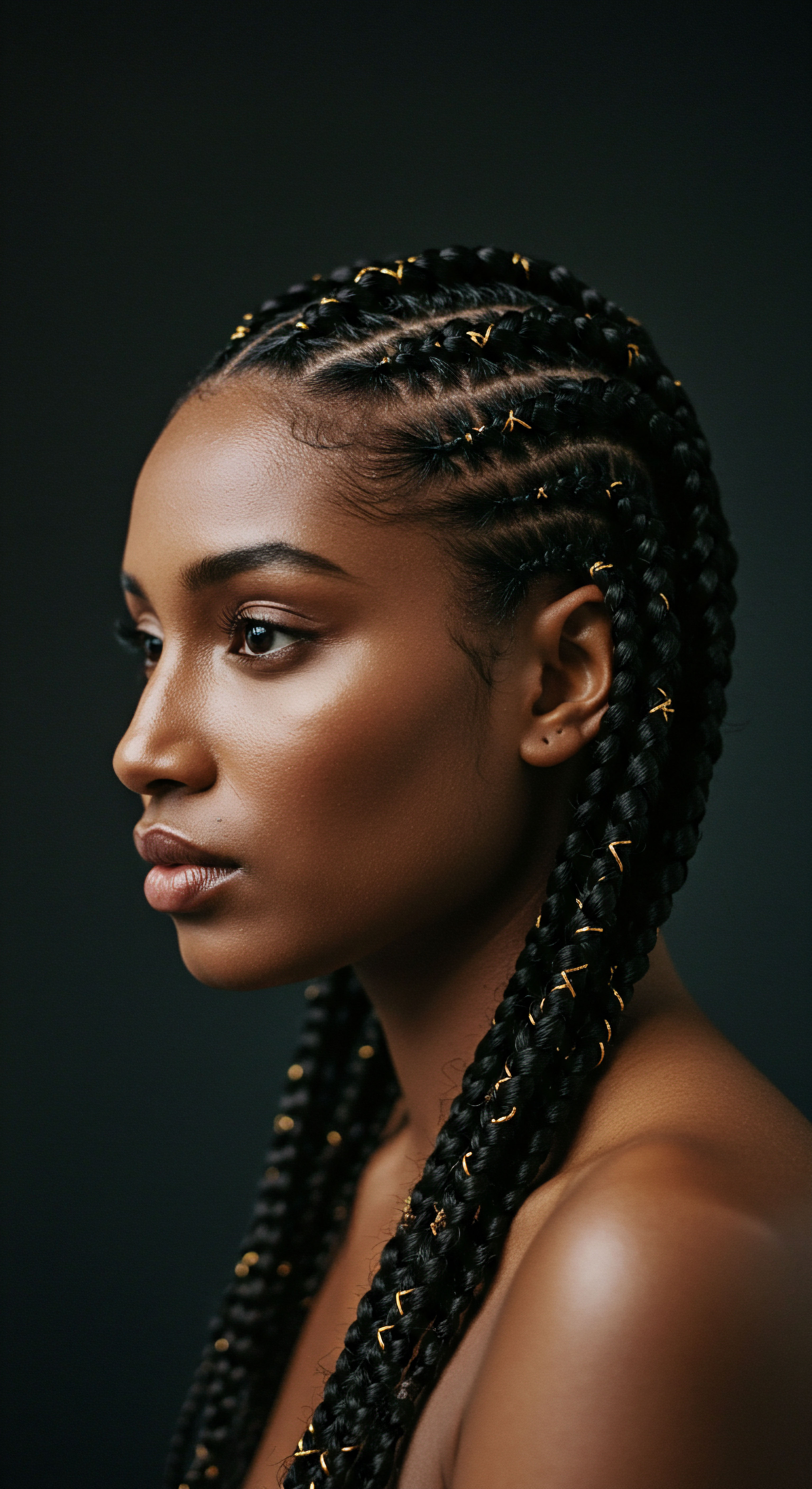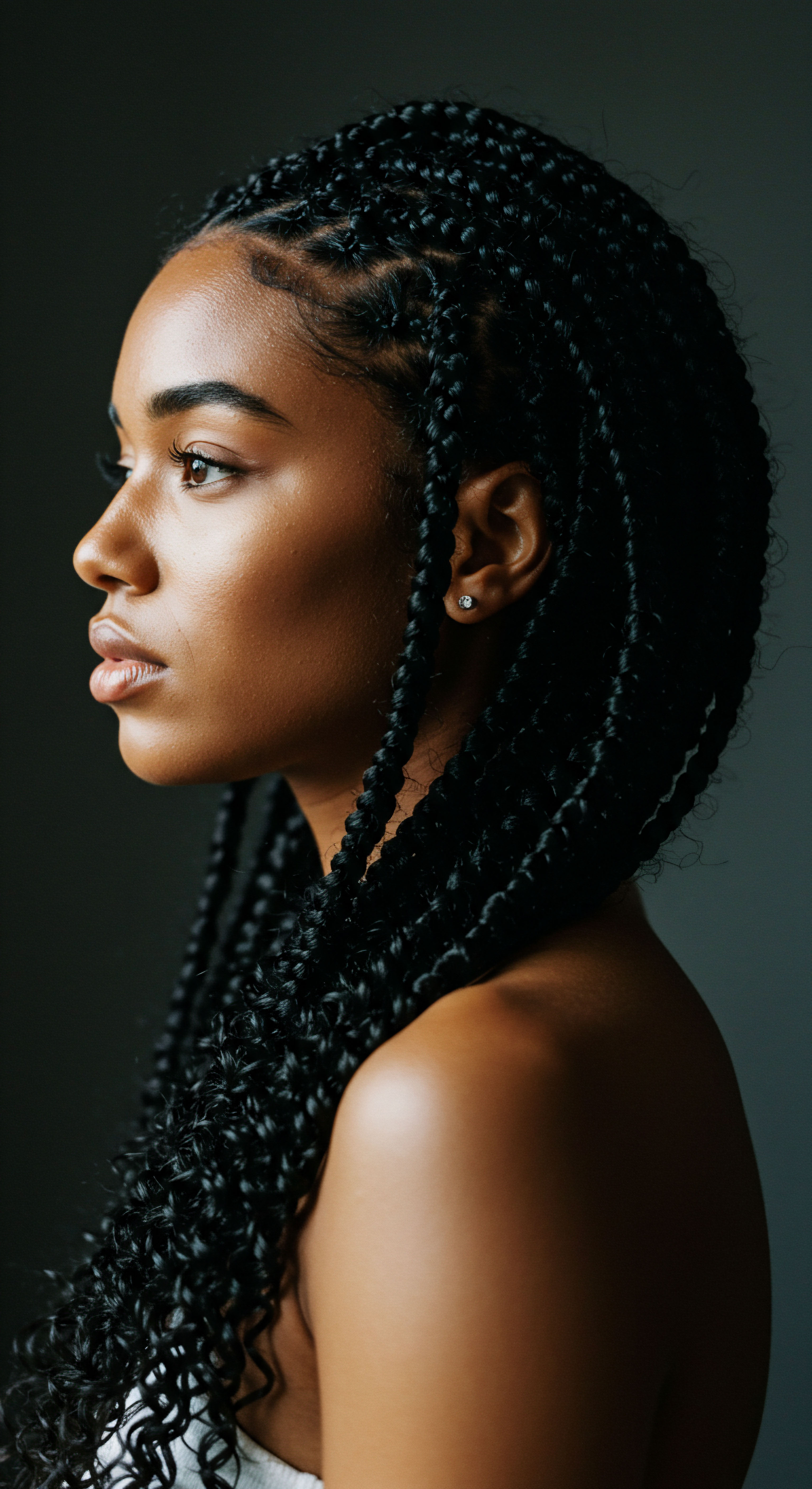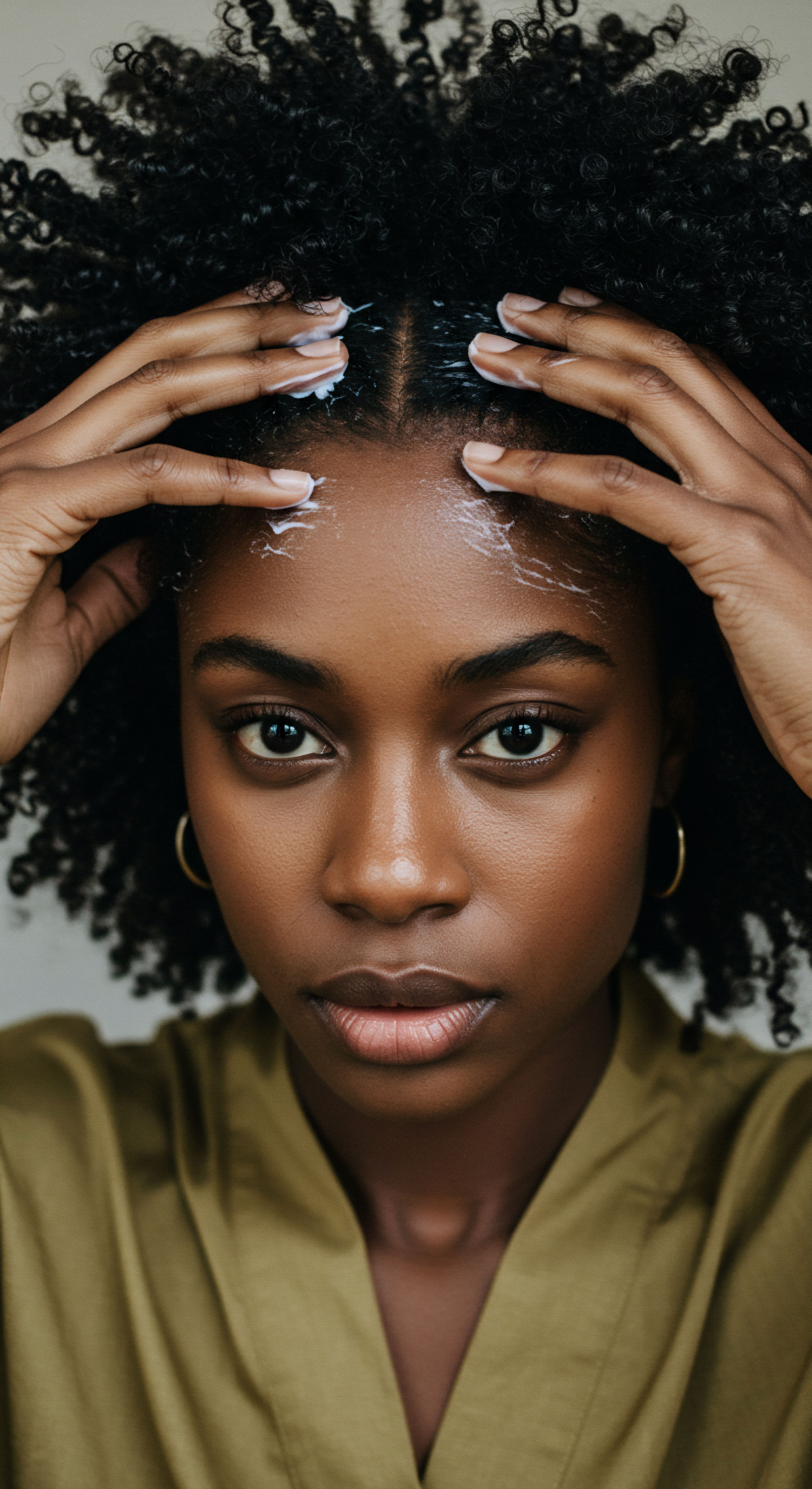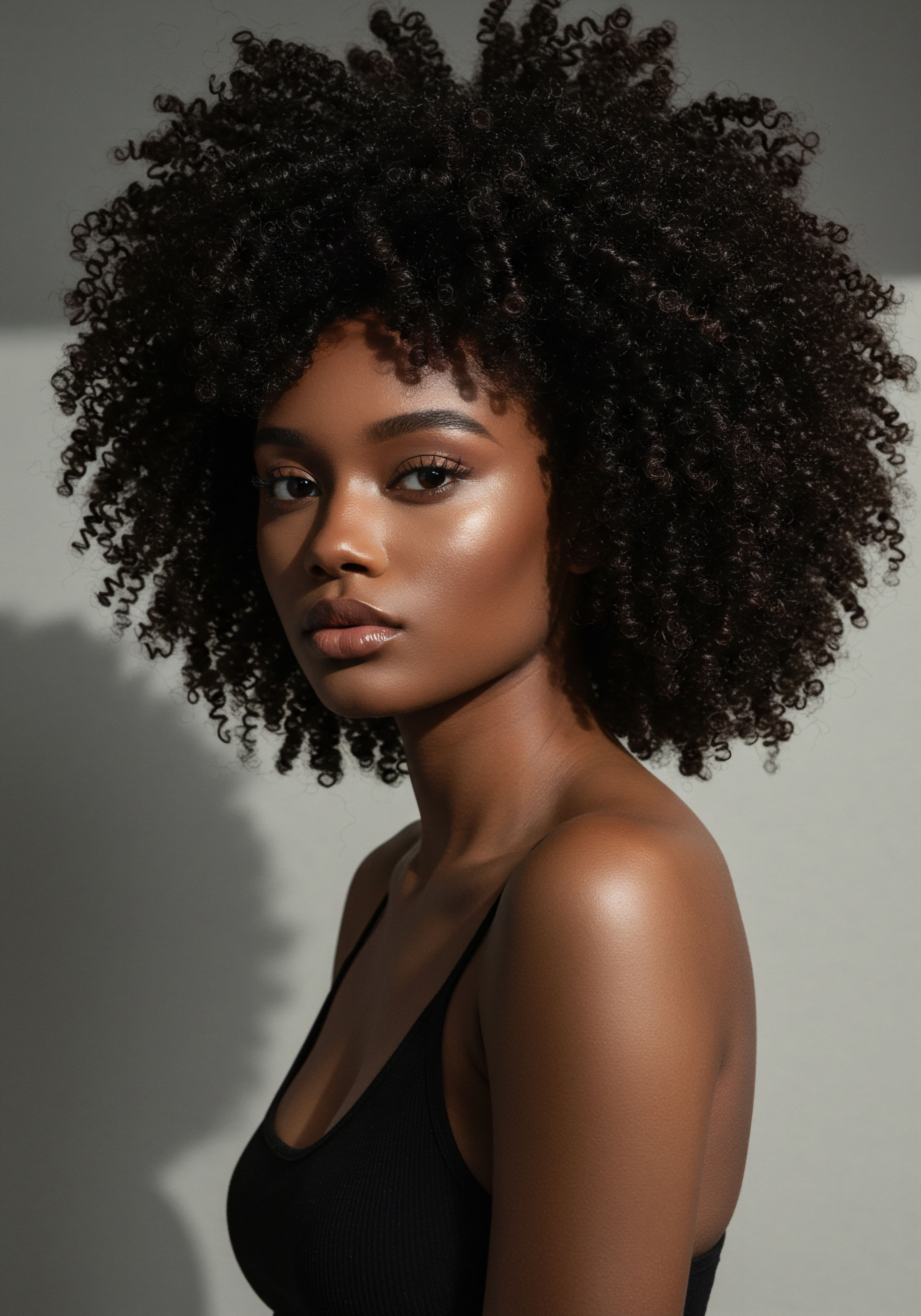
Roots
The quiet observation of hair, its texture, its journey from scalp to strand, often reveals a universe of unique considerations. For those with textured hair, this observation deepens into an appreciation for a distinctive biological design, one that calls for a nuanced understanding of its foundational needs. It is a gentle invitation to explore the very beginnings of hair health, where the scalp, often overlooked, holds secrets to vibrant growth and enduring well-being.
The skin that cradles our hair, the scalp, functions as the soil from which our strands grow. Its health dictates the vitality of the hair it produces. For textured hair, the inherent structure of the hair follicle and the curl pattern itself introduce distinct elements to this delicate ecosystem.

The Architecture of Textured Hair Follicles
Unlike the more circular follicles that produce straight hair, textured hair emerges from an elliptical, or S-shaped, follicle. This distinct curvature means the hair shaft itself grows in a spiral or coiled pattern. This anatomical difference profoundly influences how natural scalp oils, known as sebum, travel down the hair shaft.
Sebum, a protective and moisturizing substance, struggles to navigate the tight bends and turns of coiled strands, often leading to a natural dryness along the lengths, even if the scalp itself produces ample oil. This uneven distribution is a primary consideration in textured hair scalp care, necessitating external moisture application to compensate for the hair’s inherent design.
The follicular shape also contributes to the hair’s inherent fragility. The points where the hair bends most sharply are areas of increased vulnerability, making textured hair more prone to breakage than straighter hair types. Understanding this foundational architecture is the first step toward building a care regimen that honors the hair’s delicate nature.

The Language of Hair Texture
To speak meaningfully about textured hair, a shared lexicon becomes helpful, though it is important to remember that classification systems are merely guides, not rigid boundaries. The Andre Walker Typing System, while not without its criticisms regarding inclusivity and qualitative measures, categorizes hair into types 1 through 4, with textured hair falling predominantly into Type 3 (curly) and Type 4 (coily/kinky). These types are further subdivided (a, b, c) based on the tightness of the curl pattern, from loose waves to extremely tight, zigzag coils.
- Type 3 Hair generally presents with distinct S-shaped curls that are well-defined.
- Type 4 Hair ranges from tight corkscrew curls to wiry curls with sharp angles and very tight zigzag patterns.
Each sub-type presents subtle variations in how sebum distributes, how moisture is absorbed, and how susceptible the strands are to external factors. This nuanced understanding allows for a more personalized approach to scalp health, moving beyond generic recommendations to address the specific needs of each unique texture.

What is the Scalp Microbiome’s Role in Textured Hair Health?
Beneath the surface, an unseen world thrives on our scalp ❉ the microbiome. This delicate balance of microorganisms—bacteria, fungi, and yeasts—plays a significant role in scalp health. A healthy scalp microbiome contributes to the scalp’s immune protection and helps prevent common conditions like dandruff and irritation. For textured hair, research suggests the microbiome can exhibit unique differences.
A balanced scalp microbiome is essential for maintaining the health of hair follicles and preventing common scalp conditions.
For instance, studies have shown that an imbalance in the scalp microbiome, particularly an overgrowth of certain yeasts like Malassezia, is associated with dandruff and scalp discomfort, a condition often experienced by individuals with textured hair. While the exact mechanisms are still being explored, the unique environment created by the tightly coiled hair, which can impede sebum distribution and potentially lead to product buildup, might influence the composition of this microbial community. Recognizing this interplay opens avenues for scalp care that aims to foster a harmonious microbial environment, promoting overall scalp vitality.

Ritual
As we turn our gaze from the fundamental science of textured hair to the daily practices that shape its reality, we step into the realm of ritual. Here, practical wisdom intertwines with mindful actions, transforming routine care into a nurturing experience. For textured hair scalp care, this shift from understanding to application is crucial, acknowledging the unique challenges and opportunities that arise in the everyday handling of these beautiful strands.

Hydration ❉ The Lifeline of the Scalp
The inherent tendency for textured hair to experience dryness along its length extends to the scalp itself. While sebaceous glands produce sebum, the coiled nature of the hair shaft often means this natural moisturizer struggles to reach the entire scalp and the hair’s full length. This predisposition to dryness can lead to irritation, flakiness, and discomfort if not adequately addressed.
A fundamental ritual, therefore, involves consistent and gentle hydration. This begins with washing, a step that, for textured hair, requires a thoughtful approach. Infrequent washing can lead to product buildup and an irritated scalp, potentially worsening conditions like seborrheic dermatitis.
Conversely, overly frequent or harsh washing can strip the scalp of its protective oils, exacerbating dryness. The key lies in finding a balanced rhythm, often once every 1-3 weeks, depending on individual hair type and product use.
Choosing the right cleansing agents is equally significant. Gentle, sulfate-free shampoos are often favored, as they cleanse without unduly stripping the scalp’s natural moisture. Following cleansing, the application of rinse-out conditioners, sometimes with the aid of gentle heat, helps replenish moisture. Leave-in conditioners, creams, and oils then become essential companions in maintaining scalp hydration between washes.

Porosity ❉ A Guide to Product Absorption
Understanding hair porosity, the hair’s ability to absorb and retain moisture, provides a powerful guide for product selection and application. This characteristic is determined by the state of the hair’s outermost layer, the cuticle.
For textured hair, porosity can vary significantly, even across different sections of the same head.
- Low Porosity Hair possesses tightly closed cuticles, making it resistant to moisture penetration. Products may bead on the surface. For such hair, lightweight, liquid-based products and gentle heat during conditioning can assist in opening the cuticle to allow for better absorption.
- High Porosity Hair has more open or raised cuticles, which absorb moisture quickly but also lose it just as rapidly. This can lead to persistent dryness and frizz. Deep conditioners, sealing products, and protein treatments are often beneficial for high porosity hair to help fortify the cuticle and retain hydration.
Knowing one’s porosity, often determined by simple tests like the float test or the slip test, allows for a more tailored approach to scalp care, ensuring products deliver their benefits effectively rather than simply sitting on the surface or being quickly lost.

The Touch of Care ❉ Detangling and Styling
The physical handling of textured hair during detangling and styling directly impacts scalp health. The tight curl patterns are prone to tangles and knots, which, if not addressed with care, can lead to breakage and scalp tension.
Gentle detangling and thoughtful styling practices are vital for preserving the integrity of textured hair and preventing scalp strain.
Using a soft brush with widely spaced bristles or a wide-tooth comb is advisable, always starting from the ends and working upwards to minimize pulling at the scalp. Wetting and conditioning the hair before detangling can provide slip, reducing friction and stress on the hair follicles.
Certain styling practices, while beautiful and culturally significant, can place considerable strain on the scalp. Tight braids, weaves, and extensions, if installed or maintained improperly, can lead to traction alopecia, a form of hair loss caused by prolonged pulling on the hair follicles. Early signs of this condition include pain, redness, or small pus-filled bumps around the hairline. Awareness of these risks guides choices towards styles that honor scalp health, such as looser braids, larger sections, and regular breaks from tension-inducing styles.
| Practice Washing Frequency |
| Key Consideration Balance between cleanliness and moisture retention |
| Impact on Scalp Prevents buildup, avoids excessive dryness |
| Practice Product Selection |
| Key Consideration Matching products to hair porosity and scalp needs |
| Impact on Scalp Optimizes absorption, reduces irritation |
| Practice Detangling Method |
| Key Consideration Gentle, sectioned approach with appropriate tools |
| Impact on Scalp Minimizes breakage and scalp tension |
| Practice Protective Styling |
| Key Consideration Prioritizing scalp comfort and follicle integrity |
| Impact on Scalp Prevents traction alopecia and scalp strain |
| Practice Understanding these elements helps cultivate a mindful care ritual. |

Relay
To delve into the deeper currents of textured hair scalp care, we must consider the interplay of biological predispositions, cultural practices, and environmental influences. This exploration moves beyond surface-level discussions, inviting a profound understanding of how these elements converge to shape the unique needs of the scalp. It is a sophisticated journey, guided by research and a recognition of the multifaceted reality of textured hair.

Inflammation and Scalp Sensitivity
The very structure of textured hair, with its elliptical follicle and curved shaft, can contribute to specific scalp sensitivities and inflammatory conditions. One notable condition is Folliculitis Keloidalis Nuchae (FKN), sometimes called Acne Keloidalis Nuchae (AKN), a chronic scarring folliculitis predominantly affecting men of African descent with afro-textured hair. This condition presents as itchy papules and can progress to keloid-like scars and permanent hair loss. While its exact pathophysiology is not fully understood, mechanical injury from close shaving or chronic trauma, alongside hair texture, is thought to be a contributing factor.
A study revealed that AKN was diagnosed in 4.7% of South African boys in their final year of school and 10.5% of South African men, highlighting its prevalence within this demographic. The challenges of managing such conditions are amplified by the need for dermatologists to recognize how these manifestations differ on skin of color, as lesions may appear purple, grayish, or dark brown rather than the typical red seen on lighter skin. This underscores a broader consideration ❉ the need for culturally competent dermatological care that accounts for the unique presentation of scalp conditions on textured hair and darker skin tones.

Chemical Processes and Scalp Integrity
The historical context of textured hair care includes a long relationship with chemical straighteners, or relaxers, often driven by societal pressures to conform to Eurocentric beauty standards. While these products offer temporary alteration of hair texture, their impact on scalp integrity is a significant consideration.
Research indicates that chemical straighteners can cause scalp irritation, burning, and inflammation. Studies have associated hair relaxers with eczema, desquamation (flaking), pain, and even burns on the scalp. Beyond immediate reactions, long-term effects remain a subject of ongoing study, with some findings suggesting structural damage to the hair shaft and a reduction in hair strength.
The highly alkaline nature of lye-based relaxers, in particular, increases the risk of burns and irritation to the scalp. This scientific understanding informs a gentle approach to hair alteration, prioritizing scalp health above all else.

The Circadian Rhythm of Scalp Health
Beyond external applications, the body’s internal rhythms profoundly influence scalp well-being. Sleep, often viewed as a time of rest, is a period of intense cellular repair and regeneration for the scalp and hair follicles. Disruptions to this vital cycle can have tangible effects on hair health.
Sleep deprivation can lead to elevated stress hormones, such as cortisol, which in turn can disrupt the hair growth cycle, potentially leading to increased shedding. Moreover, insufficient sleep can hinder blood circulation to the scalp, limiting the supply of oxygen and essential nutrients necessary for healthy hair growth. The hormone melatonin, primarily known for regulating sleep, also functions as a potent antioxidant, protecting hair follicles from oxidative stress and potentially stimulating cell growth. This highlights a compelling connection between restorative sleep and a resilient scalp.
The delicate balance of the scalp’s internal environment is deeply connected to systemic well-being, including the quality of our sleep.
A recent study from March 2025, exploring the link between screen time and sleep, suggested that even one hour spent in bed in front of a screen could lead to a loss of almost 30 minutes of sleep, increasing the risk of insomnia. While not directly focused on hair, this data point underscores how modern habits can inadvertently impact the very biological processes that support scalp health. It encourages a holistic perspective, recognizing that true scalp care extends beyond topical treatments to encompass lifestyle choices that support the body’s natural rhythms.

Environmental Stressors and Hair Protection
Textured hair, particularly its finer variations, can be more susceptible to environmental stressors like ultraviolet (UV) radiation. UV exposure can cause structural damage to hair, impacting its proteins (keratins) and leading to changes in thickness and darkness. This necessitates a consideration of protective measures beyond simple conditioning.
Research has investigated the UV-protective effects of conditioners formulated with natural ingredients such as mangiferin, ferulic acid, and naringin. These compounds, known for their antioxidant and UV-absorbing capacities, demonstrated protective effects against UV-induced damage and oxidative stress in textured hair. This points towards a future where scalp and hair care for textured strands incorporates advanced, scientifically backed ingredients that shield against the subtle, yet cumulative, insults of the environment.

Reflection
As we journey through the intricate landscape of textured hair scalp care, a profound understanding begins to settle within us. It is a knowing that transcends simple product recommendations, reaching into the very core of identity, history, and scientific discovery. The unique considerations for textured hair scalp care are not merely a list of differences; they are an invitation to honor a distinct biological heritage with a blend of scientific precision and cultural reverence. This ongoing dialogue between ancestral wisdom and modern trichology promises a future where every strand, from root to tip, is understood, celebrated, and nurtured with the utmost care.

References
- Davis-Sivasothy, Audrey. The Science of Black Hair ❉ A Comprehensive Guide to Textured Hair Care. SAJA Publishing Company, 2011.
- Ogunbiyi, Adebola. “Acne keloidalis nuchae ❉ prevalence, impact, and management challenges.” Clinical, Cosmetic and Investigational Dermatology, vol. 9, 2016, pp. 483-489.
- DermNet. “Folliculitis keloidalis.” DermNet.
- Onejeme, Chinenye. “Enhancing Dermatological Care ❉ Understanding the Science and Significance of Afro-Textured Hair.” VisualDx Guest Blog Post, 6 Sept. 2024.
- Noma Sana. “Understanding Hair Porosity ❉ What It Means for Your Textured Hair.” Noma Sana Blog, 2 Jan. 2025.
- Oceane Avakian. “The Importance of Sebum for Your Scalp.” Oceane Avakian Blog.
- L’Oréal Paris. “What is Sebum on the Scalp & Hair?” L’Oréal Paris Hair Care.
- Les Secrets de Loly. “Textured Hair ❉ Avoid Greasy Hair.” Les Secrets de Loly Blog, 8 Apr. 2022.
- Columbia Skin Clinic. “Why Do I Have an Oily Scalp?” Columbia Skin Clinic Blog, 23 Mar. 2023.
- Kate Holden Clinic. “Afro-Textured Hair.” Kate Holden Clinic.
- Carra. “The Science of Textured Hair.” Carra Blog, 26 Mar. 2021.
- EBSCO Research Starters. “Afro-textured Hair.” EBSCO Research Starters.
- Noma Sana. “The History of Straightening Afro and Textured Hair.” Noma Sana Blog, 30 Oct. 2024.
- Sally Beauty. “Textured Hair Health ❉ Scalp Care For Curly Hair.” Sally Beauty Blog, 1 Dec. 2023.
- British Association of Dermatologists. “Caring for Afro-textured hair.” British Association of Dermatologists Patient Information Leaflet.
- St George’s Hospital. “Afro-textured Hair.” St George’s Hospital Patient Information Leaflet.
- Anais Brasileiros de Dermatologia. “Effects of chemical straighteners on the hair shaft and scalp.” Anais Brasileiros de Dermatologia.
- MDPI. “The Genomic Variation in Textured Hair ❉ Implications in Developing a Holistic Hair Care Routine.” MDPI.
- MDPI. “Exploring the Use of Natural Ingredients for the Protection of Textured Hair from Ultraviolet Radiation ❉ An In Vitro Study.” MDPI.
- Centre Clauderer. “Hair and Sleep ❉ The Importance of the Night for Hair Health.” Centre Clauderer Blog.
- Clinikally. “Impact of Sleep Deprivation on Hair Health.” Clinikally Blog, 16 Jul. 2024.
- ResearchGate. “Weekly hair washing ❉ The recommended solution for women with afro-textured hair to alleviate dandruff and scalp discomfort.” ResearchGate.
- ResearchGate. “Hairdressing is associated with scalp disease in African schoolchildren.” ResearchGate.